Loops are the most common fingerprint patterns, accounting for 60%-70% of all patterns, where ridges enter from one side of the finger, make a U-turn around a central point (core), and exit on the same side of the finger. This characteristic U-turn of the ridge is called a “recurve”.
However, all U-turn patterns are not considered as loops. There are some sort of rules that a ridge pattern must follow to consider a loop.
Rules and Requirements to Define a Fingerprint as Loop
These are the five rules and requirements that needed to to be fulfilled to define a fingerprint as a loop.
Rule 1: At least One Ridge Enters and Exits on the Same Side
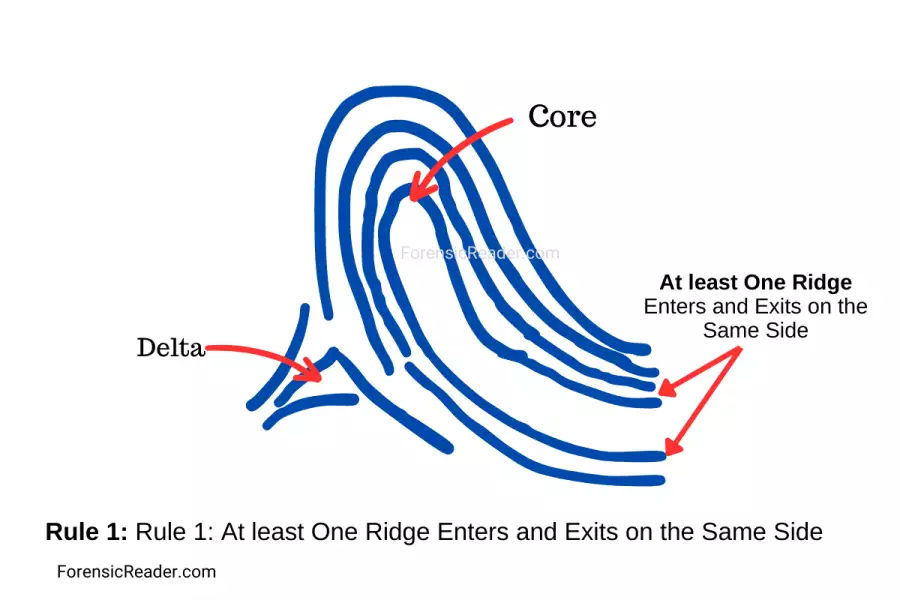
There must be a sufficient recurve ridge that enters from one side and recurve back to the same side.
And the recurve ridge must not be a case of spoil recurve. [Spoil recurve loops are the recurve that have an (or many) appended abutting at 90°.

In this example, there is only recurve ridge but it is abutted by a 90° ridge rod. That’s why this fingerprint is not considered a loop pattern (but tented arches). These types of ridge patterns are called spoiled loop fingerprints.
Rule 2: There Should Be One Delta
Every loop should have only one delta. By definition, the delta is the closed point to the divergences of the type lines (where recurve starts and terminates). They are easily seen as a triangular zone resembling a delta symbol (∆).
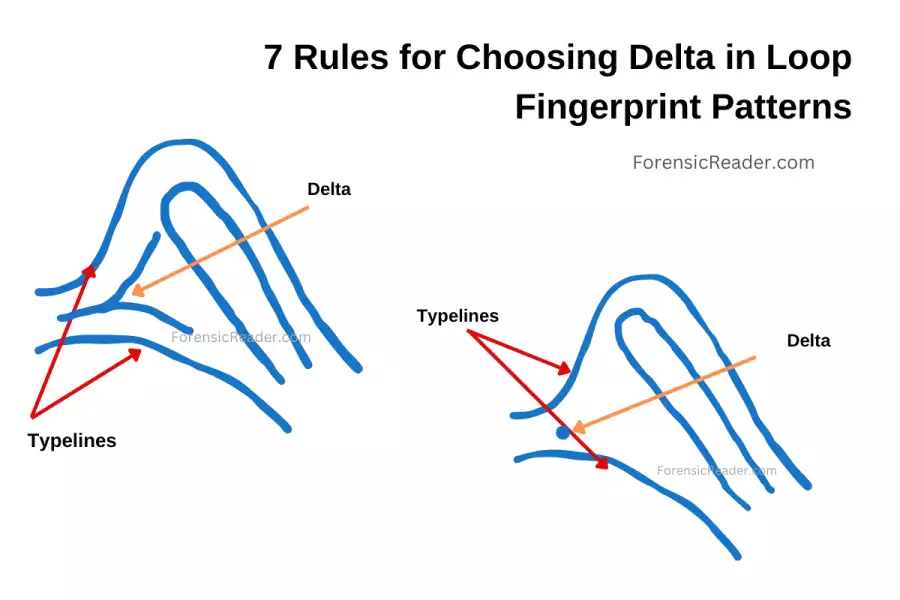
These are some rules that a loop pattern has in order to define its delta:
- Delta must be inside the type line of loop fingerprints.
- A Delta may be a bifurcation in loops.
- Choosing Delta in multi-ridge bifurcation.
- Delta may be an abrupt ending ridge.
- The Delta of a loop pattern may be a dot.
- Choosing among dots, abrupt ending ridges, and bifurcation.
Rule 3: There should be One Core
The core is the central point of the loop pattern and it can be easily identifiable as the innermost recurve without any abutting ridge.
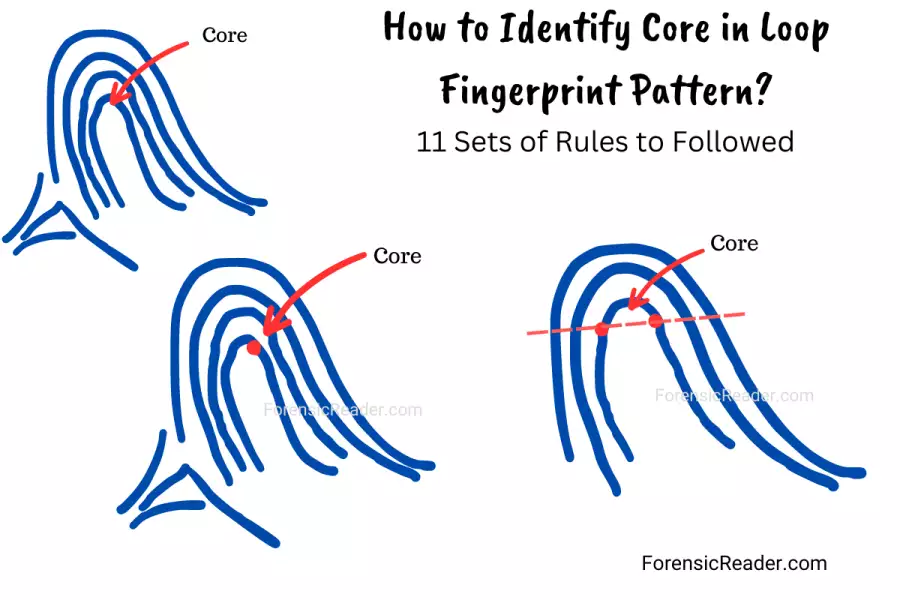
To define a core in loop patterns, there are some rules, listed below:
- The core is placed on the innermost recurve.
- Core is placed inside the shoulder of the recurve.
- Core is placed at the center for equidistant shoulders.
- Choosing the core in non-equidistant shoulders from deltas.
- Single ridge within the recurve shoulder.
- Two ridge endings within the loop shoulder.
- Three ridge endings within the loop shoulder recurve.
- Even-numbered ridges end inside the shoulder of the loop.
- Inner recurve must have no appendage abutting.
- Choosing the core in an interlocking loop pattern.
- Recurve in missing or incomplete situations.
Read More: 15+ Rules for Choosing Core and Delta in Loop Fingerprint Patterns
Rule 4: At least have One Ridge Count
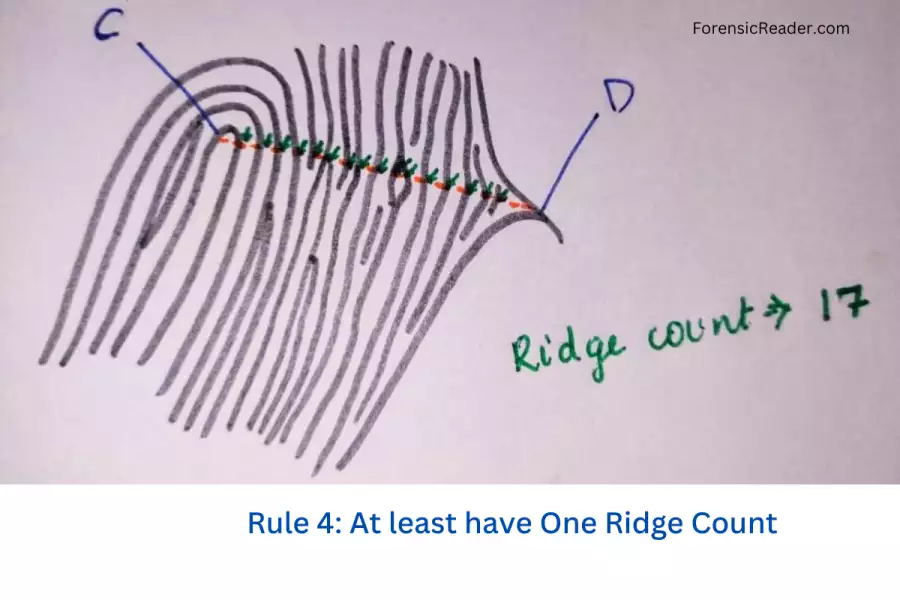
To consider a pattern as a loop, there should be at least one ridge count.
Ridge counting is a means of classification fingerprints in a computational system such as Henry Classification System.
In this, a single imaginary line is drawn between the core and delta, and intermediate ridges are counted. And there is one or more recurve ridges that must cross or touch that imaginary line.
Rule 5: What if in Loops One or More Elements are Missing?
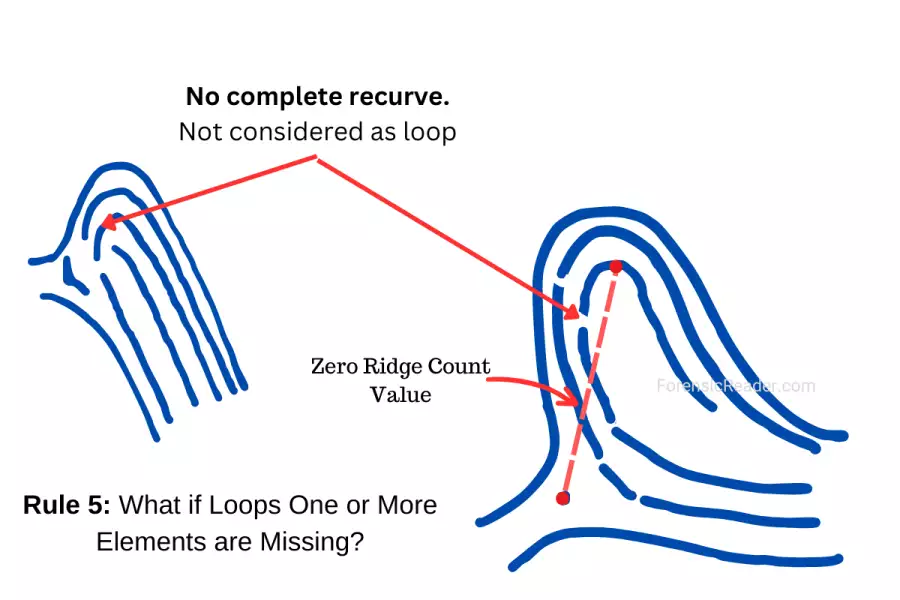
Let’s assume that the requirements and rules are not fulfilled because some of the elements are missing such as:
- Recurve missing
- Delta missing
- Ridge count missing
In these types of patterns, they are not considered as a loop. They are categorized under the tented arch.
Types of Loop Fingerprint Patterns

Loops can be subdivided into two categories based on their opening towards forearm bones and on 10-digit fingerprint cards.
1. Loop Type Based on Opening Towards Forearm Bones (Radial and Ulnar Loops)
A loop fingerprint is broadly subcategorized into radial and ulnar loops. Their names are based on the forearm bones i.e. Radius for radial loops and Ulnar for Ulnar loops.
Radial Loops Vs Ulnar Loops
A. Radial Loops (R)
- Radial Loops are the loops whose recurve opening is toward the radius bone of the forearm.
- They make a slant toward the radius bone.
- Opening follow towards the thumb.
- They are most commonly seen on the index fingers of the hands.
B. Ulnar Loops (U)
- Their opening or recurve is towards the ulnar bone of the forearm.
- They make a slant toward the ulnar bone.
- Opening follow towards the little finger.
- Most commonly seen on the index, middle, ring, and little finger.
Here is the image representation of radial and ulnar loops with respect to the radius and ulnar bones of the forearms.
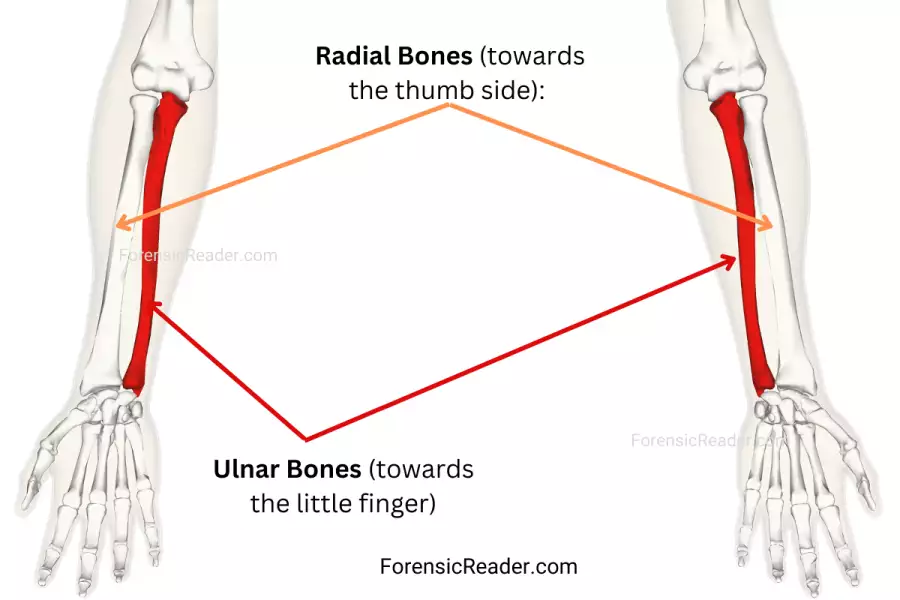
Following table state the major differences between Radial and Ulnar Loops:
| Characteristic | Radial (R) Loops | Ulnar (U) Loops |
|---|---|---|
| Definition | Loop slanted towards the radius bone of the forearm. | Loop slanted towards the ulnar bone of the forearm. |
| Flow Direction | Towards the thumb. | Towards the little finger. |
| Common Locations | Typically on index fingers. | Index, middle, ring, and little fingers. |
| Orientation (In Right Hand) | Slant towards the right side (thumb side). | Towards the left side (little finger side). |
| Orientation (In Left Hand) | Slant towards the left side (thumb side). | Towards the right side (little finger side). |
2. Types of Loops Based on 10-digit Fingerprint Systems
For purposes of automated use and a standard fingerprint system, loops are termed either a right slant (ridges flow to the right) or a left slant (ridges flow to the left) respective to the 10-digit fingerprint card.
However, they are commonly used to define slant for the fingerprint that is found at the crime scene. In many cases, it is very difficult to define the touch prints belong to which hand. In that case, categorizing loops into right-slant and left-slant loops is helpful.

These are primarily based on the slanting of loops towards the 10-digit fingerprint card.
A. Right-Slant Loops
- Also called Right Loops.
- Loops slant toward the right of the fingerprint card
- Right slant in right hand: Ulnar loop (backslash, \).
- Right slant in left hand: Radial loop (for index, R; other fingers, small ‘r’).
B. Left-Slant Loops
- Also called left loops.
- loops slant towards the left of the fingerprint card.
- Left slant in the right hand: Radial loop (for index, R; other fingers, small ‘r’).
- Left slant in left hand: Ulnar loop (forward slash, /).
Representation of Loops on Fingerprint Cards
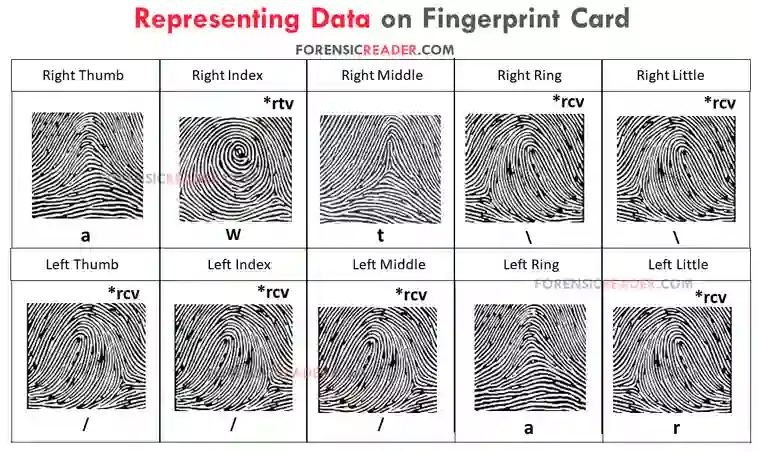
The following table is an easy representation of various types of loops and how they appear on the fingerprint card.
| Hands | Slant Loop Type | Loop Type | Symbol |
|---|---|---|---|
| Right Hand | Right Slant | Ulnar loop | Backslash (\) |
| Right Hand | Left Slant | Radial loop | R (index), r (for all fingers) |
| Left Hand | Right Slant | Radial loop | R (index), r (for all fingers) |
| Left hand | Left Slant | Ulnar loop | Forward slash (/) |
Calculating Loops Ridge Counting and Their Values
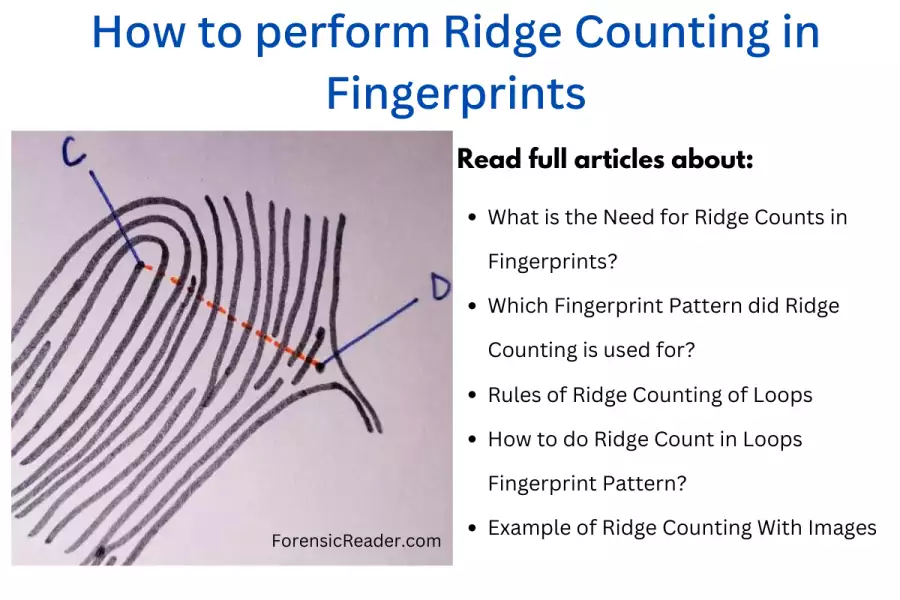
For classifying fingerprint under the subdivision of Henery, ridge count values is needed. Here are the key features of calculating and using ridge count values of loops.
- Ridge counting is another means to categorize loops in automated fingerprint systems.
- Enhance the classification process by differentiating between similar patterns.
- Make fingerprint identification systems more efficient and less time-consuming.
References:
- Fundamentals of Fingerprint Analysis by Hillary Moses Daluz
- Advances in Fingerprint Technology by Ashim K. Datta, Henry C. Lee, Robert Ramotowski
- Fingerprints and Other Ridge Skin Impressions by Christophe Champod, Chris J. Lennard, Pierre Margot
- Karu, K., & Jain, A. K. (1996). Fingerprint classification. Pattern recognition, 29(3), 389-404. [DOI]
- Wang, S., Zhang, W. W., & Wang, Y. S. (2002, October). Fingerprint classification by directional fields. In Proceedings. Fourth IEEE International Conference on Multimodal Interfaces. IEEE. [DOI]

FR Author Group at ForensicReader is a team of Forensic experts and scholars having B.Sc, M.Sc, or Doctorate( Ph.D.) degrees in Forensic Science. We published on topics on fingerprints, questioned documents, forensic medicine, toxicology, physical evidence, and related case studies. Know More.
